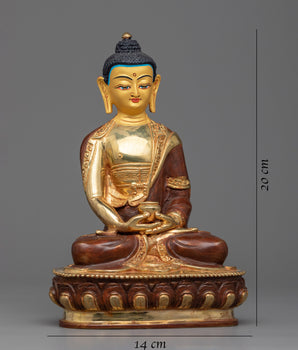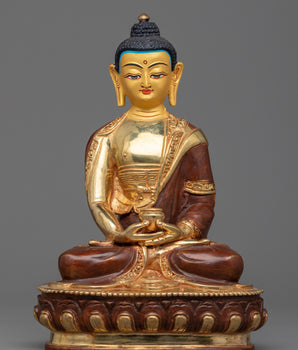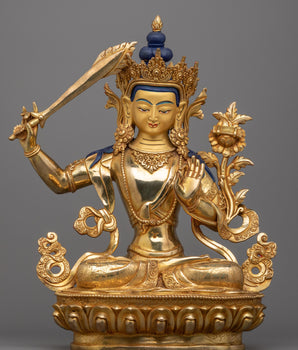









Miniature Yamantaka Sculpture with Companion | Himalayan Buddhist Destroyer of Death

100% AUTHENTIC

HANDMADE

FREE SHIPPING
Traditional Tibetan Yamantaka Sculpture with Companion | Wrathful Form of Bodhisattva Manjushri
----------------------------------------------------
Size: 5.1”/13cm (Height) x 3.7”/9.5cm (Base)
Weight: 0.55 kg
Material: Gold & Acrylic Paintings, Oxidized Copper Body, Silver Plated
----------------------------------------------------
About Our Statue:
The Yamantaka Sculpture with Companion symbolizes the strength of the conqueror of death and ignorance. This statue, measuring 5.1"/13cm (Height) by 3.7"/9.5cm (Base) and weighing 0.55 kg, encapsulates Yamantaka's transformational force, making it a treasured addition to any spiritual collection. The sculpture, crafted from oxidized copper with fine silver plating and acrylic paints, depicts Yamantaka with a fierce expression, representing his role as the wrathful manifestation of Manjushri.
Yamantaka is depicted in his wrathful form, holding various weapons and symbols of power, while his consort is shown in a close embrace, symbolizing the union of wisdom and compassion. The intricate details of their fierce expressions and dynamic postures convey the intensity and strength needed to conquer ignorance and death. The presence of the consort highlights the balanced and complementary forces that are essential for spiritual awakening.
Yamantaka, the wrathful manifestation of Manjushri, is one of the most formidable deities in Tibetan Buddhism. Known as the "Conqueror of Death," Yamantaka embodies the ultimate power to overcome ignorance, delusion, and death itself. His fierce appearance, combined with the presence of his consort, symbolizes the union of wisdom and compassion, as well as the transformative power of the enlightened mind. Yamantaka is revered as a powerful protector of the Dharma, guiding practitioners through the most challenging aspects of their spiritual journey.
Introduction to the Yamantaka Statue
The Yamantaka statue is depicted in various forms, one of which is Yamantaka Ekavira, meaning "lone hero." He has a bull's or buffalo's head with long horns as the central feature, among many others. There are eight primary heads, with the Bodhisattva Manjushri's little crowned head at the pinnacle. Yamantaka is dressed in an elephant-skin robe, a garland of freshly cut human skulls, snakes, interwoven bone ornament bracelets, necklaces, and a girdle. Except for his adornments, he is naked. A flaming halo is behind him, and his erect phallus has a crimson tip. He wields a chopping knife (Kartika) in his primary hands, symbolizing his power to sever the root of illusion.
How do you take care of your statues?
• Place them at room temperature, avoiding direct sunlight.
• Make sure that the area where your statue is placed is entirely free of moisture and dust.
• Place it at the highest place on your altar after being consecrated by a Lama/monks. The best practice is to keep them covered inside a glass cabinet.
• Do not use your bare hands or any objects with a rough surface to wipe the face. Directly touching objects with the bare hand can smudge the face, leaving scratches.




















